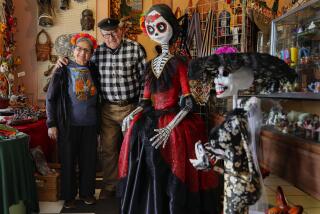Old Edna’s kicking up her heels again
- Share via
Reporting from San Luis Obispo County — At age 101, it’s a wonder that Old Edna is still standing upright. But there she is, along California 227 south of San Luis Obispo, encouraging passing motorists to stop and say “hello.”
She had some hard years -- especially during World War II -- and they took their toll. Edna turned dull gray. Clearly weather-beaten, she developed rusty-brown splotches that, untreated, grew ever larger.
FOR THE RECORD:
Old Edna: A photograph that accompanied a Nov. 22 article about Old Edna, a village near San Luis Obispo that was once decrepit but is now attracting tourists, incorrectly identified the photographer as Jay Jones, who wrote the story. The photo was provided by Pattea Torrence, who bought Old Edna when it was a ghost town in 2000, and was taken by Joe Johnston. —
“I could not see my sweet girl mistreated,” says Pattea Torrence, an area resident who had been a frequent visitor for decades. “[She] deserved some attention -- a bit of cosmetic surgery, you might say -- a much-needed bit of lipstick in order for her to stand tall again and greet the passersby.”
Torrence’s intervention began nine years ago. But instead of consulting plastic surgeons and cosmeticians, she turned to plumbers and carpenters for advice. Although Torrence refers to Old Edna as a human being, “she” is, in fact, a two-acre plot of land dotted with five buildings. They are all that remains of what once was a thriving little town. It’s name? Edna, of course.
The “Old” was added in 2000 when Torrence, who’d played amid the ghostly remnants as a teenager, bought the town site for $530,000 and, with her father’s help, began restoring the sagging structures. She realized that with eight wineries within about two miles, Edna was ideally situated to become a welcoming way station.
A derelict, single-story farmhouse was transformed into a charming bed-and-breakfast. A barn became an artist’s studio. But the biggest project was breathing life into the ramshackle, two-story building that once had been the hub of village life.
Before Edna’s demise in the 1940s, people would visit it to buy groceries at the general store, mail letters at the post office and socialize in the dance hall upstairs.
The resuscitation wasn’t easy.
“It was nearly falling down, [and] it was leaky,” Torrence says of the building with its broken, boarded-up windows and rusting, corrugated tin walls.
First to open in the building was an antiques shop; home décor items and wine-related gifts have since been added. Later came a deli, with seating indoors and on a deck, and a studio/gallery for painter Tracy Taylor. Along with locally produced wines, the deli serves overstuffed sandwiches named after people who once lived in Edna. The Zene has Black Forest ham topped with Jarlsberg cheese and sautéed apples, and the Rochella, named for Zene’s sister, contains fresh mozzarella, tomato, basil and pesto.
Outside, an orange bicycle rests against a white picket fence. A few feet beyond is the former farmhouse, now the 1,200-square-foot B&B.
Wisteria vines with their purple flowers and rose bushes with their white blooms welcome overnight guests to the cottage. The three-bedroom, one-bath home is unusual in that it’s not subdivided; the renter -- whether one person, a couple or a group -- has the run of the place. Some use it for a secluded weekend retreat, others simply for the solitude it offers.
“I’ve had writers hunker down in here,” Torrence says. “They don’t want to be disturbed.”
Andrea Plavi of San Diego stayed in the cottage, along with members of her family, as they prepared for her wedding in 2007. “We loved it,” she recalls. “We thought it was super charming.”
An old outbuilding that’s been turned into a cozy breakfast nook and a second farmhouse that’s now the caretaker’s cottage complete the property inventory. That is, unless you include the treehouse.
It is perched in the branches of a sturdy pepper tree that folks once were tied to in order to keep them from driving after they’d had too much to drink. The treehouse even has its own deck, with a hand-painted sign warning: “No girls allowed.” Torrence’s father, Walter, built it a few years ago for his grandson, Kienun. Since the completion of the treehouse, Walter has been sidelined by failing health and the death of his wife, Pattea’s mother.
“I can always fix an old building, [but] not people,” Pattea says wistfully. “I sank myself into this project instead of going to see a shrink. . . . [It] continues to be my savior.”


